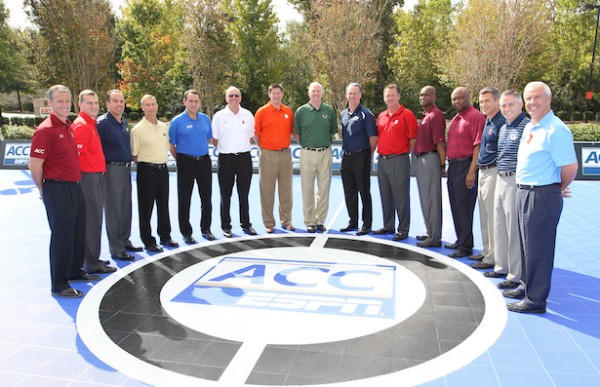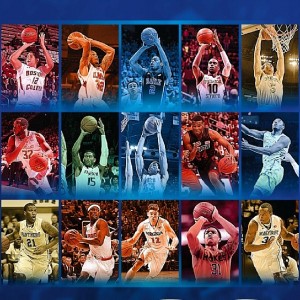New-Look ACC Ready to Proclaim Itself Best Conference Ever… But Is It?
Posted by Lathan Wells on October 17th, 2013The 2013-14 Atlantic Coast Conference men’s basketball season is a mere three weeks away, but the buzz about the conference’s potential began in early July when Syracuse, Pittsburgh and Notre Dame officially became members. The staggering history among the conference’s basketball programs was thus enhanced, and talk about the dynastic possibilities of the ACC in the present and years to come has been touched on by just about every coach in the league. The coaching legend that is Duke’s Mike Krzyzewski famously exclaimed on May 24 that the inception of the three teams previously aligned with the Big East into the fold would mean, “We’re going to be a 10-bid conference. We’re going to be the best conference in the history of the game. It’s exciting to be part of that.”
Now that’s a bold proclamation, even from someone with the sterling resume of Krzyzewski. After delving into a variety of metrics, though, it becomes clear that this league is something special this year (and will be that much more formidable in 2014-15 when reigning national champion Louisville joins the fold), even relative to what is considered some of the greatest college basketball conferences ever assembled. But if metrics exist to suggest the current ACC belongs among the elite of the elite, then that means there are metrics that can be used to track its progress as the season moves along to see how it stacks up with the other all-time greats.
One such measuring stick is the number of teams included in the NCAA Tournament, a perennial sign not only of a conference’s strength from within, but also how it handles non-conference foes during the regular season. The record for most teams selected for an NCAA Tournament happened as recently as 2011, when the Big East (interesting, right?) placed 11 of its 16 squads in the Big Dance. However, only three of those teams made it as far as the Elite Eight (although one was the eventual national champion, Connecticut). Looking at this year’s ACC, it’s difficult to project anywhere close to 11 NCAA participants, but being battle-tested in conference play proved to be a boon to the Big East two years ago. Could the same happen with the ACC this year? Some of the presumed middle-of-the-pack teams, such as an NC State team forced to replace a bevy of talent, for example, must rise to become a force for the league to boast the fantastic depth it claims it will have.
When assessing the coaching ranks, it’s hard to argue against the notion that this is the greatest collection of coaching talent ever fielded within one league. Out of the 17 national titles won by active coaches nationwide, seven reside in the ACC (Krzyzewski has four, UNC’s Roy Williams two, and Syracuse’s Jim Boeheim one). Those same three coaches represent three of the four most NCAA victories of all time, again led by Coach K with 82 (Williams is third with 51, and Boeheim fourth with 50). Krzyzewski also owns 11 Final Four appearances, second only to John Wooden’s 12, and Williams has a fifth-best seven trips to his credit. When you factor in the additional bodies of work of coaches like Notre Dame’s Mike Brey, Pittsburgh’s Jamie Dixon and Miami’s Jim Larranaga, combined with the promise of big things to come from Mark Turgeon (Maryland), Tony Bennett (Virginia) and Mark Gottfried (NC State), the conference can surely claim the country’s greatest group of coaching talents.
Perhaps the greatest obstacle the ACC faces in its claim to be the greatest league ever assembled is the realignment factor. With the new “super-conferences,” including the 11-bid Big East of a couple of years ago, most fans and pundits will argue that parity is gone and that the conferences are too big to even compare with their brethren from years past. The Big Ten, from 1976-81, won three national titles and put five different teams in the Final Four. This was during an era in which the NCAA Tournament field was either 32, 40, or 48 teams, a far cry from the present day where 68 teams are allowed entry, some with dubious credentials.
Similarly, the mid- to late-1980s Big East was able to stake its claim as the preeminent conference in the land despite much different circumstances from today’s postseason setup. Boasting a mere nine members, the league placed Georgetown into the Final Four in 1982 and 1984 and the Hoyas along with two more teams in the 1985 Final Four in 1985. Syracuse and Providence would make the national semifinals in 1987 and Seton Hall followed suit in 1989. Even if the ACC were to do the same today over a period of several years, college basketball purists would argue that a league so large and with so much history should have that kind of postseason success.
So how does today’s 15-team Atlantic Coast Conference distinguish itself as college basketball’s greatest of all-time? Postseason success is a must, of course, but the league can’t just laud the exploits of its most recognizable programs. Duke, North Carolina, and Syracuse making continual deep runs into the Tournament and holding lofty Top 25 rankings during the regular season is not going to convince anyone the ACC holds the “best ever” crown. Pittsburgh and Notre Dame need to make deep postseason runs consistently. NC State and Virginia, among others, need to become more than just bubble teams or squads that make continual early postseason exits. Teams that fall into the middle of the pack or even the lower rungs of the conference standings must win meaningful non-conference games, such as within the annual proving ground that is the ACC/Big Ten Challenge. UCLA dominated the college basketball landscape in the 1960s and 1970s, but that didn’t lead anyone to proclaim the Pac-8 (now Pac-12) Conference as the greatest in the land. One, or a few, dominant teams does not a historic conference make.
The ACC has a rich history, and many believe its golden years preceded the new millennium. The 1980s and 1990s produced numerous supremely talented teams from the conference, and the league was significantly smaller then. The battle today’s conference finds itself fighting in this historical argument is size and top-to-bottom significance. When Louisville lands in the ACC next year, the conference will have four of the preeminent basketball programs of all-time along with Duke, UNC, and Syracuse. But it’s what the other members do to keep up that really strengthens Coach K’s and others’ argument. The 2013-14 season looks to be a fantastic and competitive year for the ACC, but whether the conference proves to be the most elite collection of teams of all-time will take time, and perspective, to decide.













































